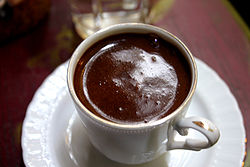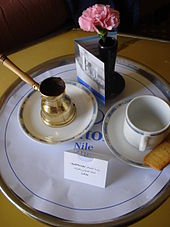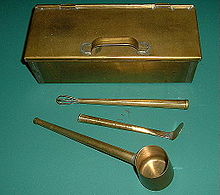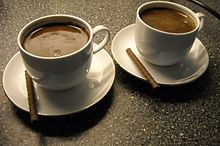- Turkish coffee
-
Turkish coffee (also Arabic coffee, Armenian coffee, Greek coffee, and more) is a method of preparing coffee where finely powdered roast coffee beans are boiled in a pot (cezve), with sugar according to taste, before being served into a cup where the dregs settle. This method of serving coffee is common throughout the Middle East, North Africa, the Caucasus, and the Balkans.
While the word 'coffee' comes from Arabic, coffeehouse culture developed in the former Ottoman world, and this was the dominant style of preparation.
Contents
History
The first evidence of brewed coffee as a beverage comes from 15th-century Yemen.[1] The word 'coffee' in most languages is derived directly or indirectly from the Arabic word قَهوه qahwah. By the late 15th and early 16th century, coffee had spread to Cairo and Mecca.[2][3]
The Ottoman chronicler İbrahim Peçevi reports the opening of the first coffeehouse in Istanbul:
Until the year 962 (1554-55), in the High, God-Guarded city of Constantinople, as well as in Ottoman lands generally, coffee and coffeehouses did not exist. About that year, a fellow called Hâkem (Hakam) from Aleppo and a wag called Şems (Shams) from Damascus, came to the city: they each opened a large shop in the district called Tahtakale, and began to purvey coffee.[4]Various legends involving its introduction at a "Kiva Han" in 1475 are reported on web sites, but with no documentation.
Coffee has affected Turkish culture so much that the Turkish word for breakfast, kahvaltı literally means "before coffee" (kahve 'coffee' + altı 'under/before'), while the Turkish word for brown is kahverengi, literally meaning "the color of coffee". In recent times, Turkish coffee has become less popular than tea (which was grown locally, and could be bought without hard currency), instant coffee, and other modern styles of coffee. At the same time, it is served by international coffee chains such as Starbucks and Gloria Jean's Coffees in their stores located in Turkey, although it remains as an option, not a promoted beverage.
Another cultural presence of Turkish coffee is to be found in matrimonial customs. As a matrimonial prologue the prospective groom's family has to visit the prospective bride's family to ask their permission and blessings for the marriage. During this meeting, the prospective bride has to prepare and serve Turkish coffee to the guests. For the groom's coffee, the bride uses salt instead of sugar to gauge his character. If the prospective groom drinks his coffee without any sign of displeasure then the prospective bride assumes that the groom is good tempered and patient.
Name and variants
Until recently, Turkish coffee in the Middle East was called simply 'coffee' in the local language.
In Turkey "kahve" (ultimately deriving from the Arabic: قهوة, qahwah) was assumed to be 'Turkish coffee', until instant coffee was introduced in the 1980s. Today, younger generations refer to it as Türk kahvesi (Turkish coffee).
The word for "coffeeshop" in Modern Standard Arabic is مقهىً (maqha, literally meaning "place of coffee", plural, مقاهي maqahi(n)), but the more common term in colloquial Arabic is simply قهوة (qahwa), meaning "coffee" in much the same way as French uses café for both things.
In many languages, the term "Turkish" coffee has been replaced by the local variant name as a political euphemism. For example in "Armenian Coffee" (Հայկական սուրճ haykakan surj), "Greek coffee" (ελληνικός καφές ellinikós kafés), and "Cypriot coffee" (κυπριακός καφές kypriakós kafés), or dropped altogether. The words for "coffee" and "coffeeshop" remained unchanged in Greek as in the other Balkan languages, using the Ottoman Turkish forms kahve and kahvehane: Bulgarian кафе, кафене; Macedonian кафе, Serbian кафа, кафана; Croatian kava, kavana; Bosnian kahva, kafana; Slovenian kava, kavarna; Romanian cafea, cafenea; Greek καφές, καφενές (although now more commonly the Hellenized καφενείο); Albanian kafe, kafene.
Albania
In Albanian it is called Kafe Turke, which simply means "Turkish coffee" and it is a very popular drink even though lately it has lost some of its appeal on the young who prefer Italian style espressos. This coffee constitutes an essential element of the Albanian social scene.
Arab world
Turkish coffee served in Cairo
In the Arab world, "Turkish" coffee is the most common kind of coffee. It is called Arabic coffee (qahoua `arabiyah, قهوة عربية ). Only occasionally will Arabs refer to Turkish coffee as being from their native country, so constructions such as "Egyptian coffee," "Syrian coffee," "Lebanese coffee," "Iraqi coffee," and the like are heard to draw a distinction in the flavor, preparation, or presentation of two different kinds of Turkish coffee; for instance, an Egyptian using the term قهوة عربية qahoua Arabiya as distinct from قهوة مصرية qahoua Masriya would be distinguishing the Levantine from the Egyptian style of Turkish coffee. Some argue that what is known as turkish coffee is actually very close to coffee that has been made for ages in Yemen, parts of Oman and South Western Saudi. In any case, there is a very distinguished Arabic coffee that is very common in Saudi Arabia and it is very different from what is known as Turkish coffee in terms of taste, smell and color.
Armenia
In Armenia, Turkish coffee is called սուրճ (surč̣ 'coffee') or հայկական. It is either served regular (sovorakan), sweet (k’aġc’r) or without sugar (daṙë).
Bosnia and Herzegovina
In Bosnia and Herzegovina Turkish coffee is also called "Bosnian coffee" (Bosnian: bosanska kahva), which is made slightly differently than its Turkish predecessor. It is usually made with Bosnian coffee brands (including Zlatna Džezva, Minas, and Saraj Kafa). Another thing different from the Turkish way of preparing the coffee is that in Bosnia, when water reaches its boiling point a small amount is saved aside for later, usually in a coffee cup. Next the coffee is added to the pot (džezva), and than the remaining water in the cup is added to the pot and everything is put back on the heat source to reach its boiling point again which takes a couple of seconds only since the coffee is already very hot. Some consumers say that this method of preparing gives the coffee a more distinct flavor. Coffee drinking in Bosnia is a traditional daily custom and plays an important role in society, especially during social gatherings.
Bulgaria
In Bulgarian it is called Турско Кафе, which means "Turkish coffee". Interestingly enough, such preparation used to be very popular throughout the 20th Century, but mostly in home brewing, while Bulgarian cafe culture is largely espresso and cappuccino oriented. However, it has always been an essential part of Bulgarian coffee culture and social fabric. Turkish coffee was/is a favourite in friendly gatherings and reading fortunes.
Croatia
In Croatia, it is called turska kava, i.e. "Turkish coffee". Otherwise, it is known as simply kava, unless when referred to in cafes, in order to avoid confusion with other types of coffee drinks. The coffee is prepared in a dzezva where water is boiled then removed from the stove. Sugar is added and stirred to produce sweet water. The coffee is added and stirred, then returned to the stove. The coffee is ready when the surface starts to separate. The top layer is scooped and placed in the cup first, followed by the coffee. The coffee is drunk throughout the day, particularly before breakfast.
Cyprus
In Cyprus, local coffee has been called Cypriot coffee (κυπριακός καφές kypriakós kafés) since the Turkish invasion of Cyprus. The special coffee pot used in the process is called briki. Cypriot Coffee is served either unsweetened, medium sweet (1 teaspoon of sugar), or very sweet (2 teaspoons). Traditionally, Cypriot men are seen drinking coffee at village coffee shops while playing tavli or other boardgames. As in the Arab world, western coffee is usually referred to as "Nescafé".
Greece
In Greece, Turkish coffee was formerly referred to simply as τούρκικος 'Turkish'. But after the Turkish invasion of Cyprus, the name soon changed to 'ελληνικός' 'Greek':
“ "...after the Turkish invasion of Cyprus in July 1974, when Greco-Turkish relations at all levels became strained, τούρκικος καφές [Turkish coffee] became ελληνικός καφές [Greek coffee] by substitution of one Greek word for another while leaving the Turkish loan-word, for which there is no Greek equivalent, unchanged." [5] ” Hungary
Hungarians simply call the beverage Turkish Coffee (török kávé). This way of drinking coffee is no longer popular in Hungary but some restaurants still have it on the menu. It was popular in the 1980-1990s as expensive machines were not needed to make it, only ground coffee, a cup and hot water. At that time one could not buy ground coffee in shops, but with electric coffee mills in bigger shops, it was milled on the spot.
Iran
Iran is a huge importer of Turkish Coffee. Despite the wide popularity of Nestlé's Instant Coffee brand, Nescafé in this country, Turkish Coffee also has a great market.
Israel
In Hebrew it is called Kafé Turki (קפה טורקי) which simply means "Turkish coffee" whereas coffee made by pouring boiling water over the same ground beans (without cooking) is known as Kafé Botz (קפה בוץ), i.e. "mud coffee". Others may call it Kafé Shahor (קפה שחור, which means "black coffee"), since it is usually prepared without milk.
Kosovo
In Kosovo, it is also called "Kafe turke" (Albanian) or "turska kafa" (Serbian)(Turkish coffee), and it is a very popular drink within the kosovar society. Kosovars also drink it two or three times a day.
FYR Macedonia
In Macedonia the most popular term about this type of coffee is турско кафе (tursko kafe, Turkish coffee), even though the term Macedonian coffee may be used as well. The Turkish coffee is one of the basic components of the Macedonian cuisine. There is not a specific part of the day when the coffee should be consumed and it can be served anytime and anywhere in accordance to the consumer's desires. There many local Macedonian coffee brands, which are popular, but also foreign coffee brands can be bought and drank throughout the country.
Romania
In Romania Turkish coffee is called 'cafea turcească', 'cafea caimac' or 'cafea la ibric'. The pot is called 'ibric', and in Dobrogea it is made in a copper kettle filled with sand - this kind of coffee is called 'cafea la nisip'. Actually, the kettle is warmed in a hot sand recipient (can be copper or simply iron).
Serbia
Main article: Serbian cuisineIn Serbian communities, it may be called simply домаћа кафа/domaća kafa 'domestic coffee' or кафа/kafa 'coffee'. It is often called simply "Tурска/Turska" when the Serbs drink it in the "кафана/kafana" (coffee house). Especially strong coffee (горка/gorka) (without sugar and milk) is often referred to as 'Turkish' or 'black' coffee. It is very popular drink in Serbia, and the Serbs drink it during meetings with friends, family and other social gatherings. usually 3-5 or more times per day. It is usually made with џезва/džezva (small coffee pot). Another thing different from the Turkish way of preparing the coffee is that in Serbia, when water reaches its boiling point a small amount is saved aside for later, usually in a coffee cup. Next the coffee is added to the pot (џезва/džezva), and than the remaining water in the cup is added to the pot and everything is put back on the heat source to reach its boiling point again which takes a couple of seconds only since the coffee is already very hot. Some consumers say that this method of preparing gives the coffee a more distinct flavor.
Slovenia
In Slovenia it is called turška kava (regionally kôva, kavca, kofè, kofé, kofi, kafe, kafjéè, kafa, kufé, kufjè) 'Turkish coffee'. Otherwise, it is known as simply kava, unless when referred to in cafes, in order to avoid confusion with other types of coffee drinks. Especially strong coffee (without sugar and milk) is often referred to as črna kava 'black coffee'.
Equipment
Turkish coffee is normally prepared using a narrow-topped small boiling pot called an kanaka, cezve, džezva, xhezve or μπρίκι (bríki) (basically a tiny ewer), a teaspoon and a heating apparatus. The ingredients are very finely ground coffee, sometimes cardamom, cold water and (if desired) sugar. It is served in a demitasse (fincan, fildžan,filxhan or φλιτζάνι (flidzáni)). Some modern cups have handles; traditional cups did not, and coffee was drunk either by handling the cup with the fingertips or, more often, by placing the cup in a zarf, a metal container with a handle.
Traditionally, the pot is made of copper and has a wooden handle, although other metals such as aluminium with a non-stick coating are also used. The size of the pot is chosen to be close to the total volume of the cups to be prepared, since using too large a pot causes much of the foam to stick to the inside of it. The teaspoon is used both for stirring and measuring the amount of coffee and sugar. The teaspoons in some other countries are much larger than the teaspoons in countries where Turkish coffee is common: The dipping parts of the teaspoons in these countries are about 1 cm (0.4 inches) long and 0.5 cm (0.2 inches) wide.
A moderately low heat is used so that the coffee does not come to the boil too quickly—the beans need to be in hot water for long enough to extract the flavour. In a modern setting normal gas or electric heating is satisfactory. Traditional heating sources include the embers of a fire, or a tray about 10 cm (4 in) deep filled with sand. The tray is placed on the burner. When the sand is hot, the coffee pot is placed in the sand.[citation needed] This allows a more even and gentle heat transfer than direct heat.
Preparation
 Preparation of Turkish coffee.[vague]
Preparation of Turkish coffee.[vague]
Turkish coffee is a method of preparation, not a kind of coffee. Therefore, there is no special type of bean. Beans for Turkish coffee are ground or pounded to the finest possible powder; finer than for any other way of preparation. The grinding is done either by pounding in a mortar (the original method) or using a burr mill. Most domestic coffee mills are unable to grind finely enough; traditional Turkish hand grinders are an exception.
As with any other sort of coffee, the best Turkish coffee is made from freshly roasted beans ground just before brewing. Turkish-ground coffee can be bought and stored as any other type, although it loses flavour with time.
While there are variations in detail, preparation of Turkish coffee consists of immersing the coffee grounds in water which is usually hot, but not boiling, for long enough to dissolve the flavoursome compounds. While prolonged boiling of coffee gives it an unpleasant "cooked" or "burnt" taste, very brief boiling does not and shows without guesswork that it has reached the appropriate temperature.
The amount of cold water necessary can be measured in the number of demitasse cups desired (approximately 3 ounces or 90 ml) with between one and two heaped teaspoons of coffee being used per cup. The coffee and sugar are usually added to the water rather than being put into the pot first.
In Turkey, four degrees of sweetness are used. The Turkish terms and approximate amounts are as follows: sade (plain; no sugar), az şekerli (little sugar; half a level teaspoon of sugar), orta şekerli (medium sugar; one level teaspoon), and çok şekerli (a lot of sugar; one and a half or two level teaspoons). In the Arab World "sāda" (سادة plain; no sugar, meaning "black" in Arabic) or "murra" ( مرة bitter; no sugar) is common.
The coffee and the desired amount of sugar are stirred until all coffee sinks and the sugar is dissolved. Following this, the spoon is removed and the pot is put on moderate heat; if too high, the coffee comes to the boil too quickly, without time to extract the flavour. No stirring is done beyond this point, as it would dissolve the foam.
Just as the coffee comes to the boil, the pot is removed from the heat. It is usually kept off the heat for a short time, then brought to boil a second and a third time, then the coffee is poured into the cups.
Getting the thickest possible layer of foam is considered the peak of the coffee maker's art. One way to maximise this is to pour slowly and try to lift the pot higher and higher as the pouring continues. Regardless of these techniques, getting the same amount of foam into all cups is hard to achieve, and the cup with the most foam is considered the best of the lot.
A well-prepared Turkish coffee has a thick foam at the top (köpük in Turkish), is homogeneous, and does not contain noticeable particles in the foam or the liquid. It is possible to wait an additional twenty seconds past boiling to extract a little more flavour, but the foam is completely lost. To overcome this, foam can be removed and put into cups earlier and the rest can be left to boil. In this case special attention must be paid to transfer only the foam and not the suspended particles.
There are other schools of preparing Turkish coffee that vary from the above. Lebanese coffee starts with hot water alone, to which sugar is added and dissolved. The product is in essence a sugar syrup with a higher boiling point than water. The coffee, and cardamom if wanted, are added, and the mixture is stirred. It is then brought to a boil two or three times; the double (or triple) boiling is an essential part of the process, both ceremonially and—as connoisseurs claim—for the palate. It has the effect of subjecting the coffee grounds to hot (but not boiling) water for longer, extracting more flavour without imparting the "cooked" taste of over-boiled coffee.
In the Balkans, dominant practice is to fill the džezva with only cold water, and heat it until it boils. As the water boils coffee is added, stirred, and removed from the fire before the foam boils over. After the foam settles the pot is placed back onto the heat source so the water would boil again, releasing more caffeine and flavour. Sometimes the last step is skipped, to preserve the foam. This type of preparation is known as Bosnian coffee or Serbian coffee.
The Armenian mode of preparation is distinct in that all of the ingredients — water, the coffee grounds, and sugar (if desired) — are all combined in the pot before being heated. After the initial mixing the coffee is then heated but not stirred again until the coffee has finished brewing. The preparation process does not usually include boiling. The coffee is usually only allowed to rise once or twice, but never three times as is typical in the Lebanese mode of preparation.
In Bulgaria, the best practice of making a Turkish Coffee is boiling, or rather heating the water to just before a boil, adding the coffee grounds and waiting for the first rise. Once the foam rises, just before its peak, it is removed from the heat and poured on top of the sugar in the cups. The coffee is never to be stirred in the pot (or in the cups) and never allowed to rise over. The coffee is sipped and once finished, the cup is always turned over in its saucer until the grounds slowly pour out. These grounds are always glanced over for quick fortune read or a more elaborate one depending on circumstance and ability to read the images. The grounds pattern in the saucer is also taken in consideration.
Drinking
Turkish coffee is taken at extremely hot temperatures and is usually served with a glass of cold water to freshen the mouth to better taste the coffee. It is traditionally served with Turkish delight. In the Mediterranean and southeastern Turkey, pistachio grains (kakuli/menengiç) may be added into the coffee. All of the coffee in the pot is poured into cups, but not all of it is drunk. The thick layer of sludgy grounds at the bottom of the cup is left behind.
Fortune-telling
The grounds left after drinking Turkish coffee can be used for fortune-telling. The cup is commonly turned over into the saucer to cool, and then the patterns of the coffee grounds can be used for a method of fortune telling known as tasseography (Turkish: kahve falı, Greek: καφεμαντεία, kafemanteia), or tasseomancy.
Notes
- ^ Bonnie K. Bealer, Bennett Alan Weinberg, The World of Caffeine: The Science and Culture of the World's Most Popular Drug, Routledge 2001. ISBN 0415927226, p. 3
- ^ Bealer and Weinberg, p.11
- ^ Alain Huetz de Lemps, "Colonial Beverages and the Consumption of Sugar" in Massimo Montanari, Jean Louis Flandrin, ed. Food: A Culinary History, p. 387
- ^ Quoted in Cemal Kafadar, "A History of Coffee", Economic History Congress XIII (Buenos Aires, 2002) full text
- ^ Robert Browning, Medieval and Modern Greek, 1983. ISBN 0521299780. p. 16
Coffee Topics - Economics
- Fair trade
- Health effects
- History
Production by
countrySpecies and
varietiesComponents Processing Preparation - AeroPress
- Chorreador
- Coffeemaker
- Coffee percolator
- Cold brew
- Drip brew
- Espresso (lungo · ristretto)
- Espresso machine
- French press
- Instant coffee
- Knockbox
- Moka pot
- Turkish coffee
- Vacuum coffee maker
Popular
beverages- Affogato
- Americano
- Bicerin
- Cà phê sữa đá
- Café au lait
- Café con leche
- Café Cubano
- Cafe mocha
- Caffè corretto
- Caffè macchiato
- Cappuccino
- Carajillo
- Coffee milk
- Cortado
- Espresso
- Flat white
- Frappuccino
- Galão
- Greek frappé coffee
- Iced coffee
- Indian filter coffee
- Ipoh white coffee
- Irish coffee
- Kopi Luwak
- Latte
- Latte macchiato
- Liqueur coffee
- Long black
- Red eye
- Ristretto
- Turkish coffee
Substitutes Lifestyle Turkish cuisine  Category articles • Stub articles
Category articles • Stub articles
Turkish beverages For more information, see ;Category:Turkish cuisine beverages.Turkish alcoholic beverages Turkish wines - Çalkarası
- Kalecik Karası
- Kavaklıdere (wine)
- Öküzgözü
- Boğazkere
- Papazkarası
Turkish low alcohol drinks List of Turkish beveragesCategories:- Turkish cuisine beverages
- Albanian cuisine
- Arab cuisine
- Armenian cuisine
- Bosnia and Herzegovina cuisine
- Greek cuisine
- Republic of Macedonia cuisine
- Cypriot cuisine
- Croatian cuisine
- Serbian cuisine
- Levantine cuisine
- Middle Eastern cuisine
- Turkish Cypriot cuisine
- Coffee beverages
Wikimedia Foundation. 2010.




